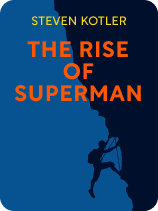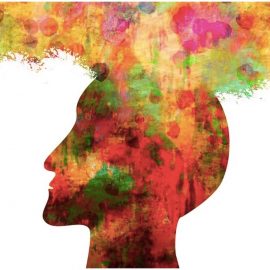

This article is an excerpt from the Shortform book guide to "The Rise of Superman" by Steven Kotler. Shortform has the world's best summaries and analyses of books you should be reading.
Like this article? Sign up for a free trial here.
Want to know how to get your brain to focus? What is a flow state? How can it help you achieve deeper focus?
According to Steven Kotler, if you want to learn how to get your brain to focus, the secret is to master a state of flow. He claims that entering a flow state allows you to achieve your most ambitious goals, and in his book The Rise of Superman, he provides four methods for achieving the flow state.
Read on to learn how to get your brain to focus, according to Kotler’s four methods.
Getting Your Brain to Focus
Although learning how to get your brain to focus is a process, Steven Kotler claims that we can explore strategies that make it easier. In his book The Rise of Superman, he explains how to enter a flow state, which teaches your brain how to focus more deeply, allowing you to perform at your best and achieve more than you thought you could. Kotler explains that there are several conditions that can trigger your brain to enter a state of deep focus.
To get your brain to focus, Kotler says you should try the following methods: seeking engaging environments, setting focused challenges, developing a growth mindset, and finding a community.
In this article, we’ll explain how to get your brain to focus, according to each of these methods.
Method 1: Seek Engaging Environments
The first method to get your brain to focus is to seek an environment that activates your senses—one that is new, unpredictable, and stimulating. Kotler explains that when you’re in an unfamiliar environment, you naturally pay more attention to your surroundings because new situations contain more risks to your well-being. We’ve evolved to be highly attuned to such threats, which prompt our brains to release neurotransmitters that give us energy and focus. This means that when your surroundings are new and uncertain, focus comes more readily.
For example, if you’re a student, you might consider doing schoolwork in a library you rarely go to. The unfamiliar people and surroundings might make you feel more energized and focused than your usual study spot.
(Shortform note: Other experts agree with Kotler’s suggestion to strengthen focus by working in engaging environments, elaborating that working in new environments energizes your mind in a similar way to meditating or taking a break. They explain that your brain has billions of neural pathways connecting different neurons. When you engage with new sights and sounds, your brain forms new connections while resting old ones, which allows you to feel more energized and refreshed.)
Kotler suggests you also seek out stimulating environments by varying your routines. For example, try eating your lunch in a park or biking to work instead of driving.
(Shortform note: Psychologists argue that there’s another reason to take up Kotler’s advice to vary your routines: While habits can make you more productive and save mental energy, occasionally breaking free from them can help you live a more fulfilling life. They explain that when you do things without thinking, you become disconnected from your present moment. By changing up your routine, you can connect more deeply with your surroundings and fully appreciate the people around you.)
Method 2: Set Appropriate Goals
The type of task you set out to accomplish also factors into your ability to get your brain to focus. Kotler gives two suggestions on how you can set goals that allow for deep concentration:
1. Find something you’re passionate about. Since enjoyment is necessary to find flow, Kotler suggests that you find something you want to achieve because you’re internally motivated to do so rather than because of outside influence. If you’re internally motivated to do something, you’ll find it easier to be more focused. On the other hand, if you’re motivated by external forces, like receiving money or avoiding punishment, you might be tempted to find distractions such as checking your phone every few minutes.
(Shortform note: Several experts weigh in with suggestions on how you can identify your passions. In Minimalism, Joshua Fields Millburn and Ryan Nicodemus suggest you consider the past experiences in your life that excited you the most. In The Happiness Project, Gretchen Rubin recommends you think about what you spent your time doing during your childhood or what you spend your free time on now to pinpoint your passions.)
2. Separate your goal into small yet challenging chunks. First, your goal must be clear enough for you to know what actions to take to achieve it and determine whether you’ve been successful. Additionally, ensure your goal is manageable so you don’t feel overwhelmed by the challenge.
For example, if your goal is to become fluent in French, you might become so overwhelmed by all you must learn that you fail to make progress. Instead, break up this big goal into smaller, measurable tasks, such as learning the alphabet or learning how to conjugate verbs.
Kotler says that the difficulty level of your goal matters, too. If your task is too easy, you can lose interest and become distracted. Kotler recommends setting challenges that are 4% more advanced than your current skill level. Such challenges help you to get your brain to focus but don’t overwhelm you.
Method 3: Develop the Right Mindset
Kotler explains that many people can feel overwhelmed and get stuck at the first stage of finding flow, when they’re initially struggling with a challenge. Kotler says that developing a growth mindset is key to progressing beyond early frustrations. When you have a growth mindset, you believe your abilities can be improved with time and work, which is important when you’re learning how to get your brain to focus more deeply. Kotler says that only when you believe you can improve can you push your performance limits.
(Shortform note: Kotler mentions the importance of developing a growth mindset, but what exactly is a mindset? In Mindset, Carol S. Dweck defines it as your attitudes about yourself, such as your skills and your intelligence, that shape the way you think and act throughout the course of your life. She explains that you start developing these beliefs at an early age based on the influence of people around you, such as your parents or teachers.)
To develop a growth mindset, Kotler suggests you seek inspiration by watching and interacting with others online. When you witness the feats others can accomplish and how they accomplish them, you adjust the frontier of what’s possible in your mind. This is known as the Roger Bannister Effect, named after the British runner who ran a mile in under four minutes—a feat many had believed to be physically impossible. Two months after Bannister proved a sub-four-minute mile was possible, another athlete ran an even faster time.
(Shortform note: Psychologists view Roger Bannister as a valuable illustration of the importance of breaking mental barriers to achieve results not just in sports, but in other areas like therapy. They argue that believing in your ability to succeed is a key factor to breakthroughs for clients in therapy who may be struggling with issues such as anxiety or substance abuse.)
Additionally, practice openness to develop your growth mindset. For Kotler, this means paying more attention to your surroundings and exercising humility. By being more in tune with your body and your environment, you become more conscious of your skills and ways that you can improve. Humility also allows you to be receptive to feedback, which drives progress. Kotler says you can practice openness through meditation, yoga, or even playing video games.
(Shortform note: While, as Kotler suggests, video games can train your attention and encourage flow, other researchers are exploring more direct connections between flow and video games. The Virtual Times project, for instance, seeks to use the Metaverse as a tool to encourage flow states and relieve certain symptoms of mental health conditions such as a distorted sense of time. The project works on the notion that virtual reality has the power to alter our perceptions of time, which can naturally encourage experiences of high concentration, immersion, and timelessness associated with flow states.)
Method 4: Find a Community
To get your brain to focus and enter a state of flow, Kotler says that surrounding yourself with a community of like-minded people can help you achieve flow and perform better. He explains that interacting with a group naturally satisfies several conditions that encourage flow. Since humans are social creatures, we tend to be more attentive when others are around. For instance, you might naturally perk up from a slouch when your work partners walk into the room.
If getting in a flow state helps you perform at your best, being in a group accelerates how quickly this happens. When someone in your group does something amazing, suddenly it seems possible for everyone else.
(Shortform note: Psychologists describe the phenomenon of enhanced performance in groups as social facilitation, a term coined by psychologist Norman Triplett in 1898. When studying bicycle races, Triplett found that cyclists achieved faster times when competing against others than when racing alone. While having other people present can improve performance on many tasks, experts point out that groups can also trigger evaluation apprehension, which is a fear of being judged negatively that can distract you and hinder your performance, especially when you’re doing a task that requires more cognitive effort.)
Not only that, we tend to be happier and more motivated when working toward a goal with a group. Kotler cites a study done by psychologist Charles Walker which revealed that people enjoyed the experience of flow more when interacting with others than when alone. However, not all groups can achieve deep focus and productivity. They must be supportive, share a sense of familiarity, and work toward a common goal.
(Shortform note: Other experts agree with Kotler’s argument that group environments can be powerful for performance as long as they’re supportive. In The Fearless Organization, Amy Edmonson writes that performance-encouraging environments offer psychological safety, which enables trust, creativity, and growth. Although she focuses on the workplace, her suggestions for cultivating psychological safety can give us insights on how to foster any kind of high performance-driving group environment. To encourage support in your group, practice active listening, share your mistakes or uncertainties, and recognize what challenges you share as a group.)

———End of Preview———
Like what you just read? Read the rest of the world's best book summary and analysis of Steven Kotler's "The Rise of Superman" at Shortform.
Here's what you'll find in our full The Rise of Superman summary:
- The importance of mastering flow for any activity
- The neuroscience behind the flow state
- Techniques for how you can encourage deep focus into your life






